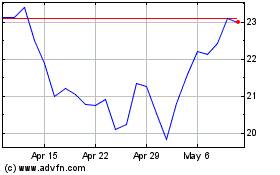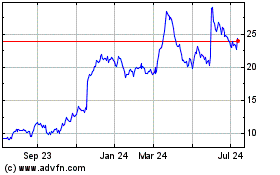By Sara Germano
PORTLAND, Ore.--Alex Haigh, a marketing coordinator for a local
Honda car dealership, gave her family a warning before the holidays
that she wouldn't be able to afford any Christmas gifts.
"Now that I'm an adult, I tell my parents I don't care about
getting anything," she said. "And since I'm broke, I don't want to
give anything."
The 28-year-old instead is using her paycheck to pay down
credit-card debt and build up savings to move from her current
apartment, shared with a roommate on the outskirts of the city, to
her own place closer to the center of Portland.
She is part of an important demographic that retailers are
trying to figure out--millennials, people born after 1980. And like
many in the group--now the largest part of the workforce--Ms. Haigh
and her roommate approach shopping in a way that retailers find
hard to crack--prioritizing experiences, like a dinner out or a
trip away, over accumulating new handbags or the latest
videogame.
Retailers from Macy's Inc. to Gap Inc., both of which reported
declines in holiday sales, have been experimenting with ways to
attract more younger customers into their stores. Macy's sees its
new line of off-price stores as a way to attract more millennials,
while Whole Foods Market Inc. is launching a smaller, cheaper chain
of stores aimed specifically at that demographic. J.C. Penney &
Co. is leaning on its in-store Sephora cosmetics shops as a way to
bring in what it calls "all-important millennial customers." Costco
Wholesale Corp. says its organic food selection is helping draw in
younger customers, noting that millennials made up a third of its
new members in the most recent quarter.
Costco Chief Financial Officer Richard Galanti warned that the
still-unpredictable millennial lifestyle habits pose challenges.
"When people talk about millennials, I think the good news is we're
getting more of them," he said last month. "Millennials are going
to be an issue for the total pie in general--if people move home
after college for a period of time, if they move into a smaller
place, if they get married later, if they have fewer kids, it's
going to rain on all of us."
Americans under age 35 form the largest age demographic of the
U.S. workforce, according to the Pew Research Center, though their
individual earning power is still growing. More than 60% of
millennials who are employed full-time, year-round make less than
the U.S. median income of $46,480, according to data from the U.S.
Census Bureau.
Ms. Haigh moved in with her high school friend Brittany Robards
three years ago, seeking to save on rent so that they could more
easily afford occasional splurges, like a recent trip to Hawaii.
They also share other expenses, like caring for their two
special-needs rescue cats.
"We're sort of like that show, '2 Broke Girls,'" Ms. Robards
said, referring to a sitcom on CBS. "We don't have a horse, but my
cat is deaf, and Alex's has three legs."
Ms. Robards, 29, works as an assistant at a local mortgage
lender and brings home about $2,400 a month, depending on
commission. She estimates that her monthly expenses--including
rent, car loan payments, phone bill, groceries and other
utilities--total about $1,500. At the same time, she is trying to
save $500 a month to eventually buy her own place, while also
paying down more than $2,000 in credit-card debt.
Even though her wages have grown, Ms. Robards says she can't
keep up with the rising cost of living in her hometown. Portland's
median cost of rent rose 20% from 2009 to 2014, above the national
average, and it is growing at the sixth-fastest rate among major
U.S. metro areas, according to the National Association of
Realtors. "All of a sudden Oregon has gotten really popular," she
said.
To cut down on expenses, Ms. Robards, a die-hard Green Bay
Packers fan, only pays for cable during the football and basketball
seasons. Her roommate, Ms. Haigh, doesn't upgrade her gadgets. "I
have a TV that I've had for five years, and I'll have it until it
breaks," she said. Both women said travel is their priority. This
fall, they jumped on a $400 airfare offer to visit a friend who
moved to Hawaii. To afford the ticket, though, they pulled back on
other spending, staying in and eating leftovers during the days
leading up to the trip. That makes it tough for retailers to pry
spending from them during the all-important holiday-shopping season
between Thanksgiving and New Year's, when retailers bring in as
much as a fifth of annual sales.
For Ms. Robards, holiday shopping required planning about a
month in advance. She identified specific gifts for each family
member--like two $41 lamps and a DVD of the Mark Wahlberg movie
"Invincible" for her father. In total she spent $250 on Christmas
purchases at only two places: Victoria's Secret and Amazon.com.
Ms. Robards reused an old trick: briefly signing up for a trial
Amazon Prime account to use the free two-day shipping option. "I
don't know why they let me do it again, since I did it two years
ago," she said, laughing. Amazon didn't respond to requests for
comment.
Ms. Haigh's Christmas austerity pledge was foiled. Normally paid
on Fridays, she got her $920 weekly paycheck on Christmas Eve--a
Thursday--and found herself unexpectedly flush the night she drove
to central Oregon to visit relatives. Taking a quick detour to
Nordstrom Rack, she picked up some dress socks for her father and a
few other assorted gifts, spending $75 in total.
But when her dad presented her with a diamond bracelet, she said
she was sheepish. "I was sort of like, 'aw, here's your socks,'"
she said. "I'm glad I ended up having the money to get them
something."
Write to Sara Germano at sara.germano@wsj.com
(END) Dow Jones Newswires
January 07, 2016 19:48 ET (00:48 GMT)
Copyright (c) 2016 Dow Jones & Company, Inc.
Gap (NYSE:GPS)
Historical Stock Chart
From Mar 2024 to Apr 2024

Gap (NYSE:GPS)
Historical Stock Chart
From Apr 2023 to Apr 2024
